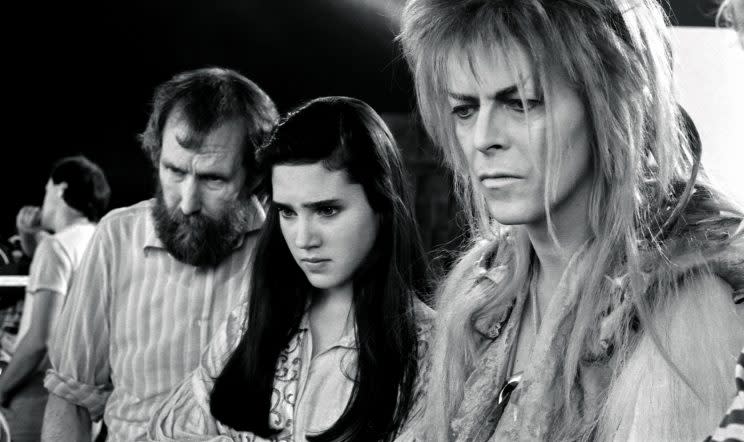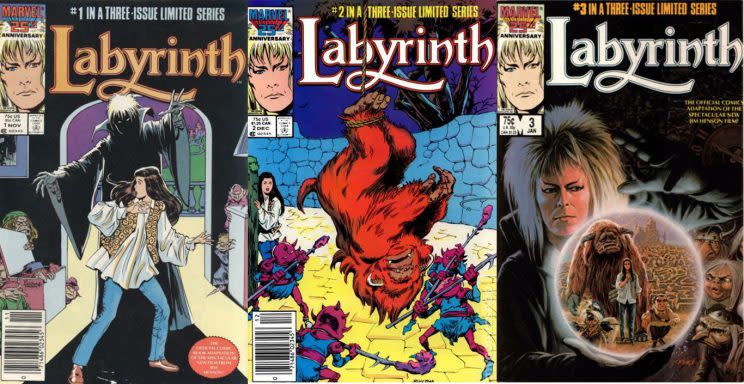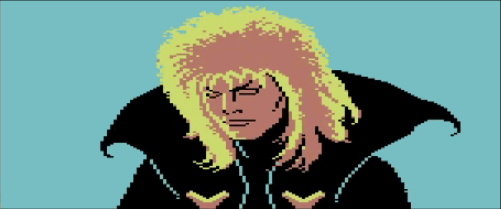10 Things You Didn't Know About 'Labyrinth': From the Other Rockers Considered for Bowie's Role to Jim Henson's Big Regret

With an enviable pedigree, Labyrinth should have been one of 1986’s blockbusters. Conceived and directed by Jim Henson, produced by George Lucas, written by Monty Python‘s Terry Jones, and starring a top-of-his-game David Bowie and a breakout Jennifer Connelly, the puppet-populated fantasy film opened on June 27 and promptly fizzled, finishing its initial weekend behind The Karate Kid Part II, Back to School, Legal Eagles, Ruthless People, Running Scared, Top Gun, and Ferris Bueller’s Day Off on its way to becoming one of the biggest disappointments of the year.
But the intervening decades have polished Labyrinth‘s legacy. Bolstered by reverential fans and revisited by new generations of kids, it has become a cult classic. To mark the film’s 30th anniversary, Sony issued a special-edition Blu-ray in September, and this week sees the release of Labyrinth: The Ultimate Visual History, a coffee-table book collecting interviews, rare art, and behind-the-scenes photographs documenting the creation of the movie. Who could have guessed that, with a few quirks of fate, we might have been celebrating something called Trapped in the Mind-Maze, starring Ted Nugent and Sarah Jessica Parker?
Related: Brian Henson Shares Memories on 30th Anniversary of Labyrinth
Authors Paula Block and Terry Erdmann shared some of their biggest discoveries with Yahoo Movies, from their favorite candid photos of Bowie on set to the mind-blowing list of reigning rock gods — Nugent included — considered for the Goblin King role. Here are 10 fantastic facts we learned about Labyrinth.
Yes, the Nuge might have played Jareth, the Goblin King, in an alternate universe
Composer Trevor Jones, who had collaborated with Henson on Dark Crystal, was pushing for a rock score. “We discussed the idea of a central rock artist who was also an actor, onscreen along with the puppets,” Jones recalls in the book. Henson sparked to the idea.
“Probably the coolest, strangest, weirdest thing that we found was Jim Henson’s handwritten list [reproduced in the book] of the musical artists he was considering for the role of Jareth. They boggle the mind,” says Block. “Can you imagine the film if the role had gone to Keith Richards?! Or David Lee Roth? Or ‘Fred’ Mercury? Or — for crying out loud — Ted Nugent?!” Aside from Bowie, other names on Henson’s list included Sting, Rod Stewart, and Prince.

David Bowie delivered, onscreen and off
Henson soon settled on Bowie, whom the Muppet master had seen up close, and ultimately the rocker was the only person offered the Goblin King gig. “He was quite experienced as an actor by then,” explains Erdmann. “He had starred in The Elephant Man on Broadway a few years earlier. Brian Henson — Jim’s son, and the lead puppeteer for the character of Hoggle — said that his dad was impressed with how courageous Bowie was onstage. They’d worried that a music artist might be afraid to show vulnerability in his performance. But they never had a moment’s doubt with Bowie.”
Related: The Allure of the Goblin King — An Appreciation of David Bowie
Adds Block: “Fantasy artist Brian Froud [who designed much of the film’s settings and characters] told us that he was convinced Bowie was the right guy to play the Goblin King the moment he met him — he was the living evocation of Pan, the lusty, playful god of the pastures. Every photo of him in the book shows Bowie’s attention to what’s going on, his playfulness, and the fun he seemed to be having.”
According to the authors, the crew was “effusive” in praising Bowie. “He was polite, friendly, and generous to everyone on the set — the opposite of what you’d think of as a rock superstar personality,” says Erdmann. “He’d come out of his trailer to chat with the crew and puppeteers, treating everyone as an equal, and go out for a beer with the gang at the end of a day.”

Jennifer Connelly beat out a lot of future famous actresses
From April 1984 to January 1985, Henson auditioned dozens of young actresses in the U.S. and U.K., among them Helena Bonham Carter, Mary Stuart Masterson, Sarah Jessica Parker, Laura San Giacomo, Laura Dern, Marisa Tomei, Jane Krakowski, Yasmine Bleeth, Ally Sheedy, and Mia Sara. Krakowski, Sheedy, and Maddie Corman (Some Kind of Wonderful) emerged as the favorites until a relatively unknown 14-year-old blew everyone away: Jennifer Connelly. “When Jenny walked in, she was the right person, and it was one of those great little moments,” Jim Henson is quoted as saying in the book. Within a week of her audition, she was offered the role of Sarah, the teenager who gets whisked away to the Goblin kingdom.
Related: Creating the Labyrinth Hands Scene
“Although she’d been in a few films prior to getting Labyrinth, what comes across most is how utterly normal and unaffected by showbiz she was at the time,” notes Block. “She was open to every experience, and game to try everything, from being suspended on wires, to being ‘hand-handled’ by the disembodied limbs in the shaft of Helping Hands.”

Labyrinth by any other name…
Henson entertained several titles before settling on Labyrinth. A handwritten note on his stationery lists several other possibilities: Magic Maze, Into the Labyrinth, Sarah’s Maze, Lost in the Maze, Trapped in the Mind-Maze, Inside Outside, Outside Inside, Turning Inside Outside, Outside In, and Inside Out. Inside Out, huh? That might have had some potential.
There was some high-profile script-doctoring
After Henson and Froud conceived a story set in a surreal world inhabited by beasties of all shapes and sizes, Henson needed a screenwriter. A big Monty Python fan, Henson contacted Terry Jones, who, it turned out, had been wanting to get in touch with Henson about adapting Jones’s Erik the Viking children’s book. Jones signed on to Labyrinth, and although he was the only credited screenwriter on the final film, plenty of others had input.
“The Henson family kindly unearthed all the early copies of the developing script for us to peruse — there were at least 25 versions, all very, very different from each other! There were three primary writers [Jones, Henson, and Fraggle Rock‘s Laura Phillips],” says Erdmann. “And Elaine May, well known in Hollywood as a talented script doctor, also took a pass at it, smoothing out the last of the rough edges before filming commenced.”
Star Wars creator George Lucas also provided some last-minute advice. “Jim was having some issues with the script and wanted to know if I would become involved,” Lucas says in the book. “We both had very strong creative visions, but the thing is, we both knew that. I said, ‘Jim, this is your movie. I’m going to help you make your movie. And when there’s an argument or a disagreement or a difference of opinion, you win.'”
One featured creature really evolved
Visual History contains tons of sketches and early drawings of the strange and wonderful denizens of Labyrinth. But one key character underwent a particularly significant metamorphosis from concept to realization. “The character of Hoggle changed the most — at least physically,” says Block. “Brian Froud had done a simple drawing and then he sculpted a miniature to work out his three-dimensional aspects.” But scaling up the character proved problematic. “Froud said, ‘We realized, and this was a pioneering moment, that we needed to put more electronics into it. I had to change his facial expressions to incorporate them.'”

Another was definitely for the dogs
“On a personal level, being dog lovers, we really liked Sir Didymus,” Erdmann says, “particularly after Cheryl Henson [Jim’s middle daughter] told us she felt Didymus was based on a feisty little dog that belonged to her older sister, Lisa Henson.”
Watch Sir Didymus and his trusty mount, Ambrosius, make the scene in Labyrinth:
Jim Henson had one regret about the film
Labyrinth would turn out to be Henson’s final film; he would die at the age of 53 four years after the movie’s release. “The film is all Jim. He came up with the original concept,” says Block. “As creator and director, he chose and approved every element that you see onscreen. He didn’t indicate that he had a favorite character, but Brian Henson feels that Jim was a bit regretful that he didn’t have time to perform any of the characters, which he always enjoyed doing.”
Erdmann also suggests that the film had a deeply personal meaning for Henson: “Mira Velimirovic, Jim’s assistant at the time, feels that the film was a kind of valentine to his three daughters, but there are also a lot of boy-oriented things for his two sons — witness the Bog of Eternal Stench! And the sons are the ones who pushed for David Bowie as the Goblin King.”
The merchandise you probably never knew existed
Because the film underperformed at the box office, it didn’t have the pop-culture impact of Henson’s or Lucas’s other fantasy films of the era, like The Muppet Movie or Star Wars. But there were costumes, record albums, souvenir books, comic books, bubblegum, board games, and even a video game. Many of these are pictured in the Visual History and can be found on eBay.


In more recent years, as the film has grown in stature, there have been new comic spinoffs and even action figures.
Why are we still stuck in the Labyrinth 30 years later?
Although Henson and Bowie (who died earlier this year) are both gone, and Connelly — who won an Oscar for A Beautiful Mind — now acts only occasionally, their collaboration is more fondly embraced now than it was upon its release. The authors point to three big reasons for Labyrinth‘s endurance.
“It’s one of the last examples of pure ‘hands-on’ fantasy filmmaking — and, in retrospect, one of the best,” says Block. “With the exception of a wonderful computer-graphic owl in the credits, every onscreen character, no matter how outlandish, is physically present. Human actors interact with inhuman creatures operated by Henson puppeteers on huge elaborate sets. Nothing was added in postproduction. They don’t make films like that anymore.”
Related: How Labyrinth Achieved Peak Practical Effects
“David Bowie’s performance is sublime,” adds Erdmann. “He’s up onscreen in all his bewigged glory, singing and cavorting in those memorably tight pants. Yet his songs, his magnetic personality, and his larger-than-life presence are what you remember after the film is over. Bowie is funny, threatening, sexy, gorgeous — and that’s from the perspective of both authors, male and female.”
And, finally, they point to the genius of Henson. “It was Jim Henson’s last feature film. He was a brilliant artist and unmatched fantasist who died way too young. Who knows what marvelous works he’d have completed in later decades? The film serves as testament to his talent.”




